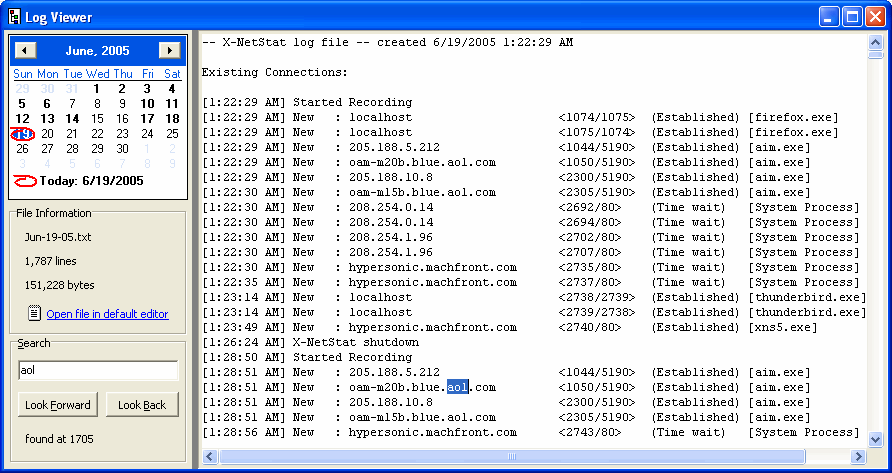You donít have to be sitting in front of your computer to catch every connection. If you turn on X-NetStatís logging features, you can record X-NetStat activity to a text file and review it later.
X-NetStat can log these events:
- New Connections
- Changes in connection state/status
- Closing connections
- Rule activity
- Use of the X-NetStat server (Remote Access)
- Connection Kills
- UDP Activity (Packet Sniffer, and "Show UDPs" must be turned on)
When logging, you can choose whether to include a timestamp for the event, the ports involved, and the process involved. Here is what a X-NetStat log file might look like with all these options on:
-- X-NetStat log file -- created 4/30/2004 8:02:29 PM
[8:02:29 PM] Started Recording [8:02:33 PM] New : 205.188.12.127 <3032/5190> (Established) [aim.exe] [8:02:33 PM] New : 205.188.6.143 <3040/5190> (Established) [aim.exe] [8:02:33 PM] New : 218.78.211.62 <3149/4661> (Established) [emule.exe] [8:02:33 PM] New : host207105075031.borland.com <3262/80> (Close wait) [delphi32.exe] [8:02:33 PM] New : 207.105.83.51 <3263/80> (Close wait) [delphi32.exe] [8:02:33 PM] New : aba23.neoplus.adsl.tpnet.pl <3436/4662> (Time wait) [System Process] [8:02:33 PM] New : 218.68.224.146 <3437/80> (Time wait) [System Process] [8:02:33 PM] New : pool80183.interbusiness.it <3439/4662> (Closing) [emule.exe] [8:02:34 PM] New : pD9E49117.dip.t-dialin.net <3441/4662> (Time wait) [System Process] [8:02:59 PM] New : moscow.uwec.edu <3001/3633> (Established) [alg.exe] [8:02:59 PM] Change: 80.13.40.17 <3548/4662> (Established->Fin wait1) [emule.exe] [8:02:59 PM] Change: 80.15.148.16 <3559/4660> (Established->Fin wait1) [emule.exe] [8:07:02 PM] New : localhost <3813/3814> (Established) [mozilla.exe] [8:07:02 PM] New : localhost <3814/3813> (Established) [mozilla.exe] [8:07:02 PM] New : 205.188.12.127 <3032/5190> (Established) [aim.exe] [8:07:02 PM] New : 205.188.6.143 <3040/5190> (Established) [aim.exe] [8:07:02 PM] New : host207105075031.borland.com <3262/80> (Close wait) [delphi32.exe] [8:07:02 PM] New : 207.105.83.51 <3263/80> (Close wait) [delphi32.exe] [8:07:08 PM] New : 216.200.111.181 <3848/443> (Established) [mozilla.exe] [8:07:21 PM] Closed: i8.cnn.net <3833/80> [mozilla.exe] [8:07:21 PM] Closed: i8.cnn.net <3832/80> [mozilla.exe] [8:07:29 PM] Closed: 80.8.55.221 <3851/4662> [emule.exe] [8:07:29 PM] Closed: 217.5.28.163 <3850/4661> [emule.exe] [8:07:31 PM] X-NetStat shutdown
| TIP: Turning on many logging options can slow down X-NetStatís
performance, especially if there is a significant amount of
network activity.
To view your Logs, click the Logs button on the toolbar or click the Logs main menu, and then click the date you want to view to open the file in Notepad. Under the Logs button/menu, only the logs from the last 7 days are displayed. Click Show all Logs to open the Logs folder in Windows Explorer and view all of them. Alternatively, you can click Log Viewer to use X-NetStatís built-in Log manager. |
 |
The X-NetStat Log Viewer

The X-NetStat Log Viewer keeps track of all log files that have been created as a result of X-NetStat monitoring connections.
To browse to a certain day's log file, just click the date on the calendar. Bold dates indicate that a log file exists for that date.
The log will be displayed in the right-side of the window in a fixed-width font. File information, including filename, lines, and size of the file are shown below the calendar.
To search for text within the log, enter your query in the Search box and hit Enter to search in a forward direction. To search backwards, click the Look Back button.